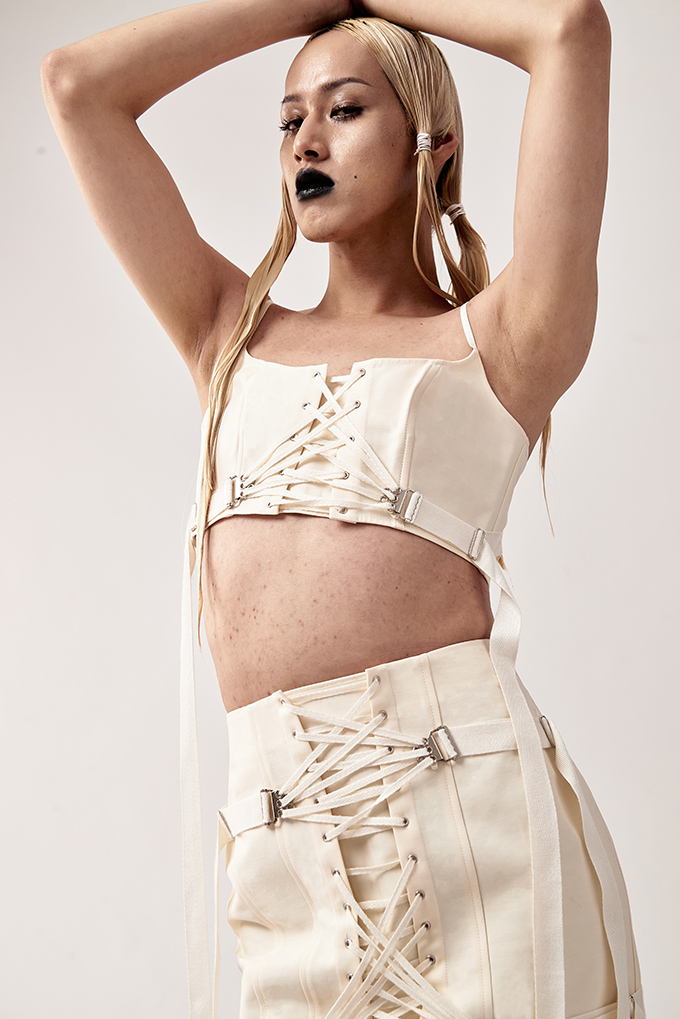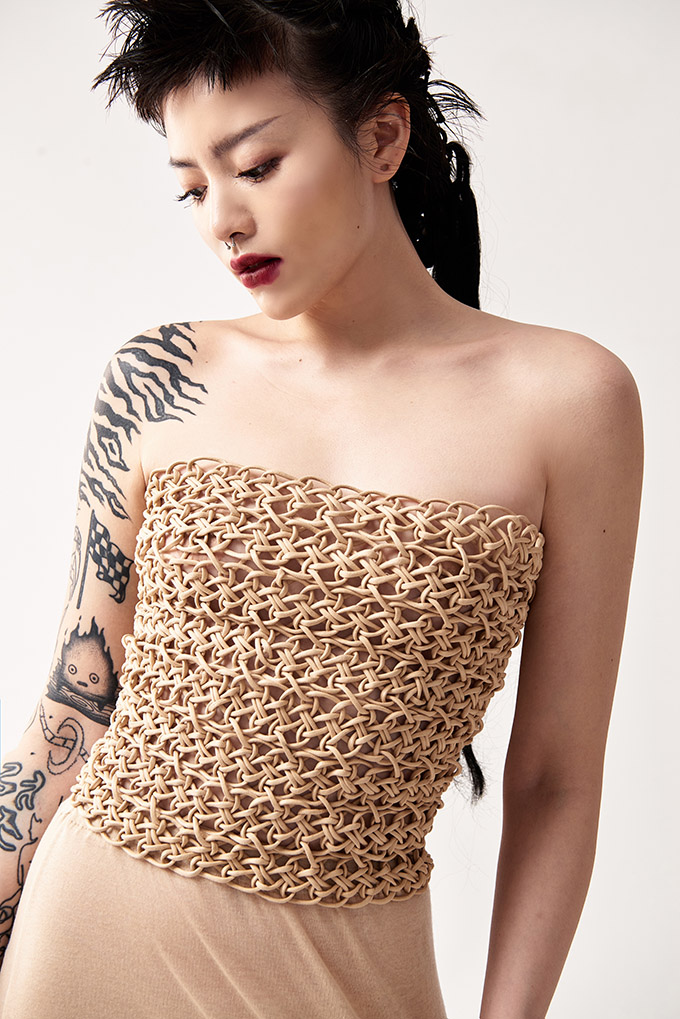Upon first glance, the appeal of Shawna Wu’s work might lie in its celebration of Chinese culture, fetishism and, well, sexiness. But beyond the red, black and white butterfly-knot harnesses and dyed corsetry—all of which make for a disarmingly appealing Instagram feed—is slow, contemplative labour. With a deep respect for rituals, tradition and handmade techniques, Wu’s pieces cut through the noise of trend-led collections. The likes of Lil Miquela and Yeha Leung have been seen in her pieces, and it’s no surprise why. There’s a quiet luxury to Wu’s body of work, and it stems from her considered assembly of textiles, technique and finish—she uses primarily deadstock and upcycled materials, and each knot, loop and twist can be felt even through the screen.
Speaking to Vogue Singapore, Wu shares more about her latest collection of ready-to-wear pieces, her creative process and who she would like to dress next.

Tell us more about your latest collection—what key themes or techniques were you looking to explore?
My accumulation of work is called ‘Bound’, and it explores the boundedness of culture, community and the emotions that keep us tethered to one another. I wanted to use textiles as language—textiles were the first form of language. I thought about what it’s like to inherit tenderness; culture or custom; shame and pride. My pieces were crafted with traditional knotting techniques; sustainable, natural, deadstock and upcycled materials; fully fashioned hand knitting; hand weaving; natural dyeing with ingredients from Chinese medicine and rare vintage fan-lacing elements.

How does this collection differ from your prior work?
This is the first time a small selection of ready-to-wear pieces will be available for purchase on my website. I especially love my 100 percent cotton sets with fan-lacing hardware. I made special one-off versions in a beautiful deadstock Chinese silk jacquard as well. I’ve also expanded my Chinese knots to also include new leather and jade and silver beaded pieces, which remind me of palace walls and protection.

Take us through your creative process—what gets you in the zone of inspiration?
I like to be alone and vibe. I love the meditative quality of textile-making and I go into an intuitive dream zone.
One of the most distinctive features of your work is the use of Chinese butterfly knots. What prompted your interest in this technique and what is the significance behind it?
I was first interested in Chinese knots when I saw one of my classmates at Parsons was working on some in class. From there, I made the personal association with shibari, fetish wear and BDSM, then took it on this tangent that felt authentic to me and in line with my values on preserving traditional textile-making techniques. I use Chinese butterfly knots a lot as I like how they look visually, and I feel that the form works as a harness. I’m also inspired by the queer and trans love story of the Chinese legend, Butterfly Lovers. To me, it’s sort of about endless love and I love the simultaneity of traditional and radical. I think it’s important for me to move away from using worn markers of ‘Asian’ aesthetic elements and actually work on continuing and preserving elements of Asian culture in my work. I want to go beyond just formal elements and work on practices integrated into life and rituals, otherwise, culture stays in a stagnant time loop. I’m making my own intersectional cultural language.

The materials you use are mostly discarded textile waste and natural fibres. Given the organic nature of both your materials and process, at what point do you decide that a piece is ‘complete’?
I think an ‘end point’ is always intuitive to any maker. Things are finished when you say they are, so it could be anytime. But the life of garments after that is a whole other thing—particularly with organic fibres. I wished more people really followed through with caring for a garment through its entire life.

Your work is largely sensual for how closely intertwined it is with the body, with elements of bondage and corsetry which have been very much gendered in fashion history. How do femininity and gender fit into your practice?
I don’t really believe in gendered clothing and I honestly don’t care to think about it that way. The body and person hold the power. Clothing is there to enhance the personal transformation and actualisation process. I believe having the agency to express your own gender identity is deeply sacred and I am humbled and fulfilled by the ways in which my clothing has helped people on their own journeys. For me, bringing out the femme energy in my work is about compassion, nurturing and care, and those things are about creating with purpose and certain ethical value systems.
Your pieces have been worn by the likes of Yeha Leung, Trinity Vigorsky and Lil Miquela. Who else would you love to see in your pieces?
Rihanna, Naomi Campbell, Arca, Bai Ling, boychild, Wu Tsang, Victoria Sin, and City Girls.
What is the hardest part of what you do, be it personal, technical or creative?
The hardest part is doing everything almost entirely by myself. I’m blessed to have friends help me along the way, but apart from that, I manage multiple jobs and hand-make many of the pieces myself—which takes hundreds of hours.
Live performance has also been a key facet of the way your work is experienced. Are there plans to further explore this in the near future?
Definitely! I am looking forward to more performances, shows and raves.





